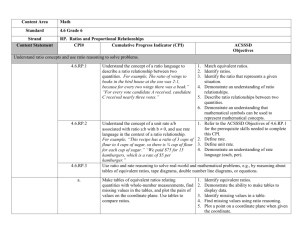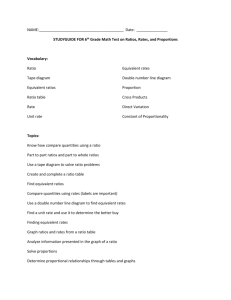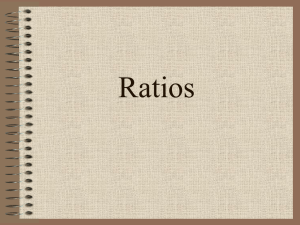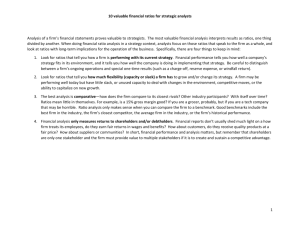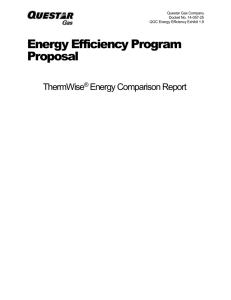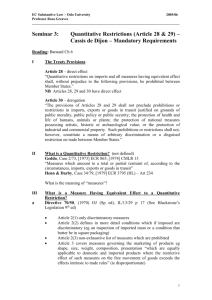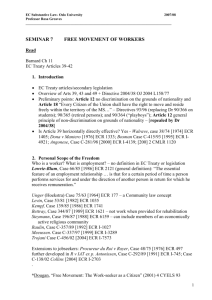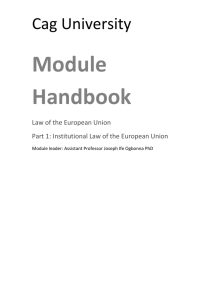Request to the ARC from the AAP Context statement The ability to
advertisement
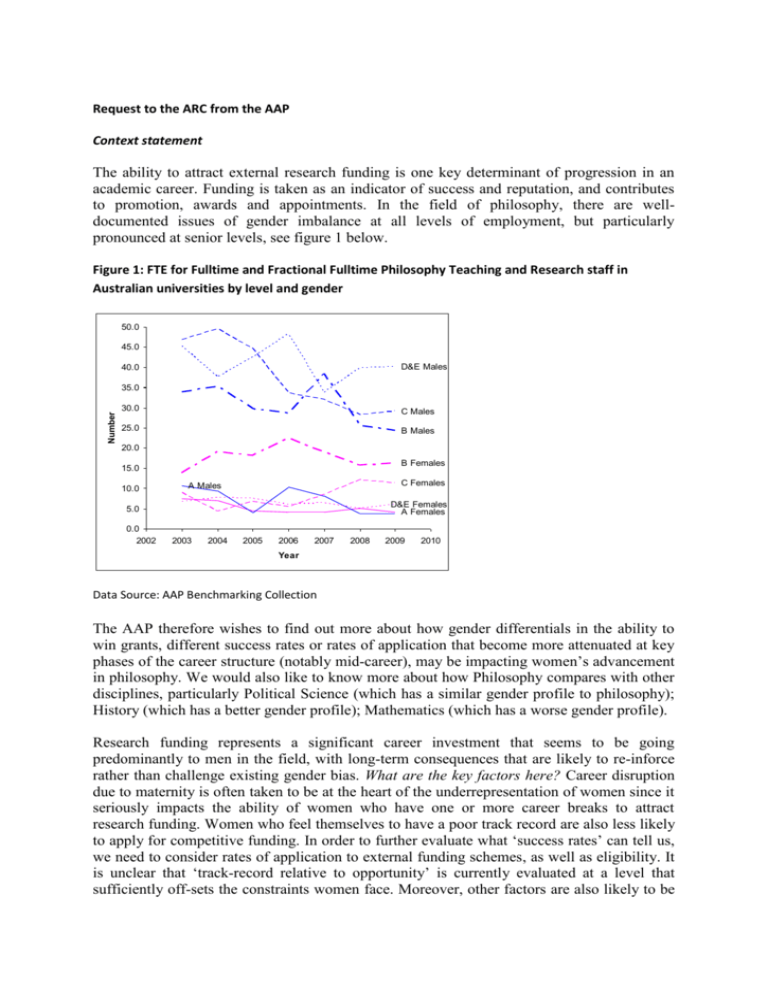
Request to the ARC from the AAP Context statement The ability to attract external research funding is one key determinant of progression in an academic career. Funding is taken as an indicator of success and reputation, and contributes to promotion, awards and appointments. In the field of philosophy, there are welldocumented issues of gender imbalance at all levels of employment, but particularly pronounced at senior levels, see figure 1 below. Figure 1: FTE for Fulltime and Fractional Fulltime Philosophy Teaching and Research staff in Australian universities by level and gender 50.0 45.0 D&E Males 40.0 Number 35.0 30.0 C Males 25.0 B Males 20.0 B Females 15.0 10.0 C Females A Males D&E Females A Females 5.0 0.0 2002 2003 2004 2005 2006 2007 2008 2009 2010 Year Data Source: AAP Benchmarking Collection The AAP therefore wishes to find out more about how gender differentials in the ability to win grants, different success rates or rates of application that become more attenuated at key phases of the career structure (notably mid-career), may be impacting women’s advancement in philosophy. We would also like to know more about how Philosophy compares with other disciplines, particularly Political Science (which has a similar gender profile to philosophy); History (which has a better gender profile); Mathematics (which has a worse gender profile). Research funding represents a significant career investment that seems to be going predominantly to men in the field, with long-term consequences that are likely to re-inforce rather than challenge existing gender bias. What are the key factors here? Career disruption due to maternity is often taken to be at the heart of the underrepresentation of women since it seriously impacts the ability of women who have one or more career breaks to attract research funding. Women who feel themselves to have a poor track record are also less likely to apply for competitive funding. In order to further evaluate what ‘success rates’ can tell us, we need to consider rates of application to external funding schemes, as well as eligibility. It is unclear that ‘track-record relative to opportunity’ is currently evaluated at a level that sufficiently off-sets the constraints women face. Moreover, other factors are also likely to be in play; for instance, the research literature presents compelling evidence of implicit bias in the differential assessment of written work and CV’s of men and women. We would like to obtain ARC data to assist in further analysis of the following perceived problems, ideally across the range of disciplines detailed above, and with a view to whether there is significant change over time: 1. Application rates: Women are not submitting as many ARC applications as men. 2. Success rates: Although success rates have been comparable in some years, in others it has been lower for women. It seems to be very variable with career stage. 3. Assessment of track-record: How well is this operating? The largest drop off in women obtaining grants seems to occur in mid-career. It tends to coincide with maternity, and the years immediately following. The current FTE calculations do not take into account that during pregnancy and after returning to work from maternity leave, women have a reduced capacity for an extended period of time. The problem is not just about the time that women took as leave but also the long term gendered patterns of care and the opportunities missed during that leave that only come once a year. 4. Assessment of Quality: Given evidence of implicit bias at work in the differential assessment of work and CV’s, do we have ways of assessing fairly the quality and potential of all male and female applicants? Do we have data on proxys for output and potential eg number of HERDC points and how these compare for male and female successful applicants? 5. $ Value of grants going to males as compared to females In more detail, we would like data on: 1. Eligibility, ‘Application rate’ and ‘Success rate’ What proportion of academic women registered with the ARC in each year of their employment (i.e. they consider applying for funding)? What is the gender ratio of staff eligible to apply for funding (i.e. academic women in particular disciplines) and those who actually apply? - Then one could compare these ratios to the gender ratio for applicants and then the corresponding ratio for successful applicants. We would like to know: 1. Success rates for women (compared to men) a. % who register with the ARC (hence are eligible to apply) b. Gender ratios of application to eligibility c. Gender ratios of success to application d. (a-c) by types of positions (0.4-1.0, contract/continuing, RO/T&R) e. (a-c) by levels of appointment (A-E) f. Gender ratios for Lead CI (by application, and by success) 2. Success/Application rates, and how these differ at career stage Key question: Are ECR women doing relatively better than older women? This is an important question for evaluating change, and where the problems for women may be arising. We would need longitudinal data to be able to tell whether ECR women do better regardless of the time period - or is it only recently that the ECR women started doing better? We need to try to separate the cohort effect (women born around 1979 have better chances women born in 1959 at the same stage of their life) from the age effect (in relative terms ECR women have always done better than middle career women although the gap might fluctuate over time). We would like to know: 2. Success rates for women (compared by age or stage of career) a. ECR/non-ECR %’s who register with the ARC b. ECR/non-ECR ratios of application to eligibility c. ECR/non-ECR ratios of success to application d. etc. (similar list to above; non-ECR breaks into more carefully defined categories) 3. Track record relative to opportunity assessment How is track record relative to opportunity currently being evaluated? Anecdotal reports suggest there may be disciplinary differences here. Do these show up as a weighting placed on track record for those who ask ‘opportunity’ to be factored in? We would also like to know: What difference would it make to the track-record score if an automatic factor for weighting the score were applied – eg x1.3 per child? [A recent proposal to the NHMRC suggested the following calculation, based on time-use data. There are surprisingly few studies on time-use of female vs male academics (apparently there is very poor participation in these studies). However, a small survey provided by Mark Ellwood from the Johns Hopkins University, Washington, US, indicated that Female Professors (n=20) spent 11 hours/per week doing research, compared with 14 hours/week spent by male professors (n=4); this count excludes hours spent on administration, teaching/advising, writing grants, refereeing papers/grants and other commitments. While this difference in working hours is likely to be much higher at more junior stages, and in the months/years following childbirth, the factor highlighted by this study: “1.3x” (times male professors spend on research compared to female professors) could serve as a very conservative starting factor to be applied to track record scores. ] 4. Assessment of Quality of CV’s Are there differences by gender in how publication profiles are assessed? The assumption that this is likely to be the case would be in line with this the existing research on implicit biases. It is of course hard to measure how this is operating outside controlled experimental situations. However, might it be possible to use HERDC points on applications as a crude measure of output and to compare how men and women were rated against this objective measure? 5. How does this relate to money? The $ value of grants seems to be going disproportionately to male academics: For instance, in the 2013 round of the DORA awards only 4 out of 37 went to women Total DORA funding Total going to women = 28,482,421 = 2,999,101 So, although women make up about 30% of academic staff they received only 10% of the DORA funding. In the humanities and social sciences (excluding psychology) $9,960,140 was distributed to men, $0 to women, yet these are the areas where women are best represented among the teaching staff. If one includes psychology among the humanities and social sciences, $12,470,129 was distributed of which just $629,101 went to a woman, that is just about 5% of funding went to women. We’d like to get a similar picture for overall Discovery Funding, ARC Professorial Fellows etc. We would like to know: a. b. c. d. e. f. g. Gender ratios, by scheme, for $’s sought. Gender ratios, by scheme, for $’s obtained. Gender ratios, by eligibility, for $’s sought. Gender ratios, by eligibility, for $’s obtained. Gender ratios, by registration, for $’s sought. Gender ratios, by registration, for $’s obtained. Similar questions, but ECR/non-ECR ratios. We would also like to know how this compares across the disciplines mentioned, and over time.





